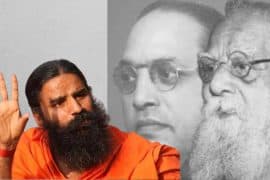Amidst the cries from monocolored kurtas with daflis of “Aao, aao, natak dekho!” and loud claps, street theatre is slowly losing its relevance around the university campus.
Street theatre in India has gained popularity with groups like Jana Natya Manch (Janam) and IPTA (Indian People’s Theatre Association) Street theatre in Delhi University is competitive, with over 60 theatre societies and various teams from institutions not affiliated to Delhi University, street theatre is about picking up social issues and coming up with the best punchlines.
Nearly every play follows the same structure, a loud opening call announcing the society’s arrival, monocolored bodies moving rapidly, members sitting in a circle as the audience stares from a distance, a two second silence and then the echo of a harmonium note. A narrator rises, they make eye contact with everybody and nobody at the same time. A scene starts unfolding in the background about something painful, someone struggling, someone yelling, which progresses to a big conflict, the drumbeats get louder, the xylophone rings louder, the actors become a part of the sound machine, the human body turns into an instrument, props made out of borrowed funds are seen flying around, the silence hits again.
Street theatre has been the platform for dissent in the country for decades. However, the competitive nature of street theatre in the collegiate circuit is fatal. Plays are designed to appease the judges rather than focusing on the masses.
There is almost very little or no experimentation, it is necessary that street theatre voices dissent however, every play tells the same story and some even have problematic depictions.
The dominance of certain societies in the theatre circuit puts forth a new angle of hierarchies within the Delhi collegiate theatre circuit and internal hierarchies within societies.
Street theatre in Delhi University has become repetitive, in attempts to become ‘woke’ and be the harbingers of social justice, plays have followed the repetitive form an some have problematic elements attached to it. Even the songs and the beats are repetitive in their attempts to be catchy. For example: a play on suicide can’t simply end with “don’t kill yourself, there is a lot worth staying alive for” or plays on gendered abuse ending with how the victim finds solidarity in a group or seeks help.
Casual sexism, misogyny and sexist humour are recurring themes in some plays.
Devanshi, the Vice President of Ibtida: the Hindu dramatics society disagrees, “ I think that the street theater that I have witnessed in the past three years has in fact worked intensively on trying to do away with casual sexism or any patriarchal mindset.
Teams have actively taken up topics that cater exactly to such ideologies so that they can be addressed out in the open. The Delhi Collegiate Theatre Circuit is progressing towards a healthier track for sure, as has been evident to me in my three years amongst this crowd. (sic)”
In attempts to make the play funny, sexist and crass humour is used, like in GTBIT’s play “Don’t kill my vibe”, depression is addressed through comedy but casual sexism takes the lead in the play. The play features only two actresses, both in the supporting role.
The involvement of the male gaze and the portrayal of female characters is also problematic, like in Amity School of Engineering and Technology’s play on superstitions and “andh-vishwas”, which depicts a graphic rape scene and various other scenes of abuse, it also victim shames instead of focusing on the bigger picture.
Graphic depictions accompanied with hard-hitting dialogues and somber music can leave a lasting impact on the audience, however it can remind many of their personal traumas. The absence of trigger warnings before plays is alarming and disturbing.
Khushboo Singh, the Vice President of Shunya: The Ramjas Dramatics Society says, “The biggest shocker is when you try to question or even educate them about the problematic things that are there in their street play, the only excuse that I get every time is “We wanted to extract the same reaction. We wanted to make you uncomfortable”
I mean, excuse me? If you are making a play on something as heinous as rape you can’t show just directly show rape in your piece. Street is open to all sorts of audiences and you never know who all are watching and what they’ve been through”
The problematic elements in street plays dealing with graphic depictions makes one question, is it really necessary?
The growing question of privilege, where upper caste folks play the roles of Dalits and the oppressed is also problematic. The exclusion of the common masses from the circuit is what makes the Delhi Collegiate Theatre Circuit an elite and closed space.
There has been a systematic attempt to silence dissent with repeated censorship in the past of street plays dealing with issues of nationalism, the Kashmir conflict etc. however, dissent cannot flourish in the same, old ways of capitalization, commercialisation and appropriation of emotions. Dissent with theatre cannot move forward with exclusion.
Image Credits: Jaishree Kumar for DU Beat
Jaishree Kumar
[email protected]




Comments are closed.